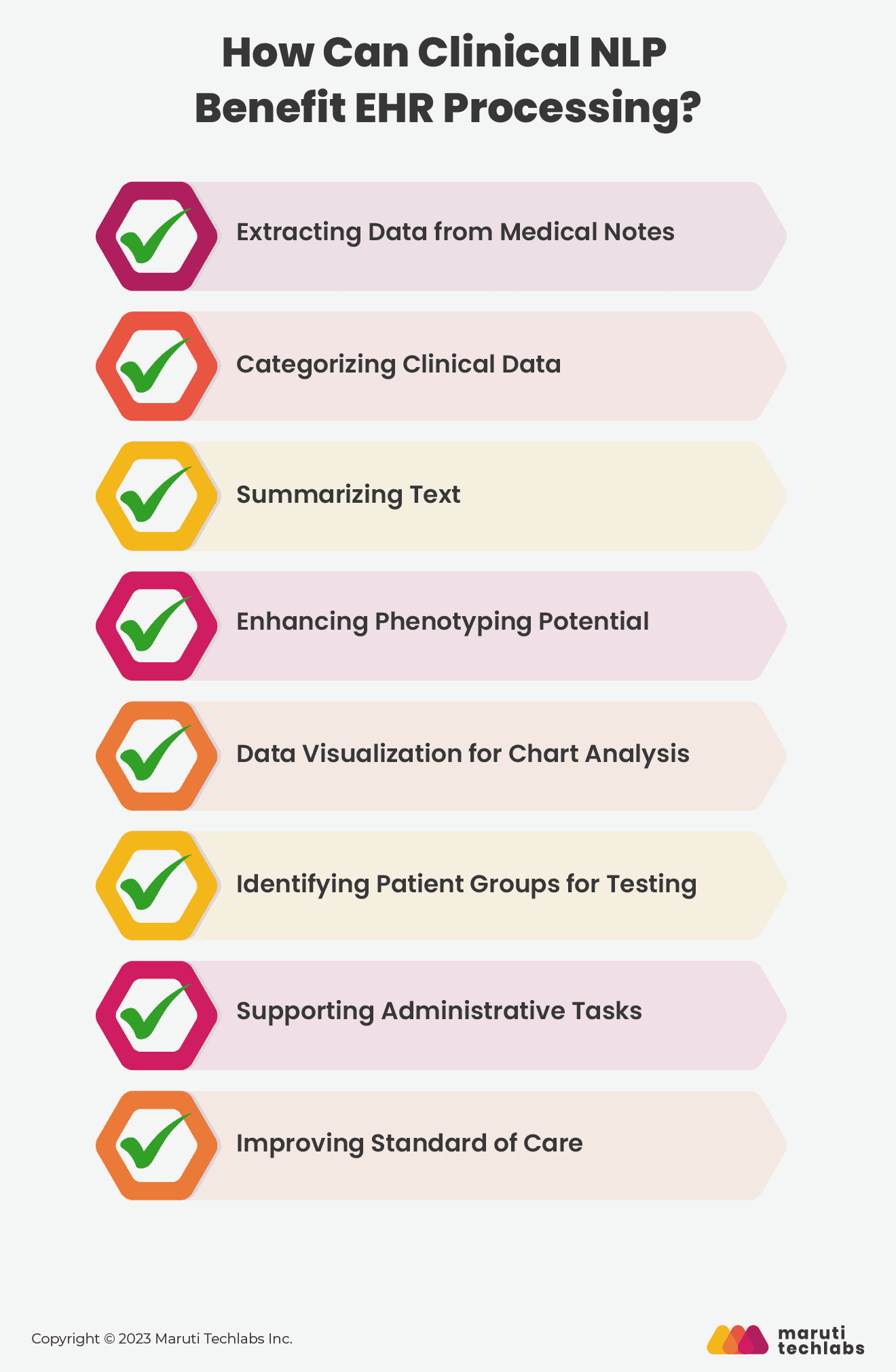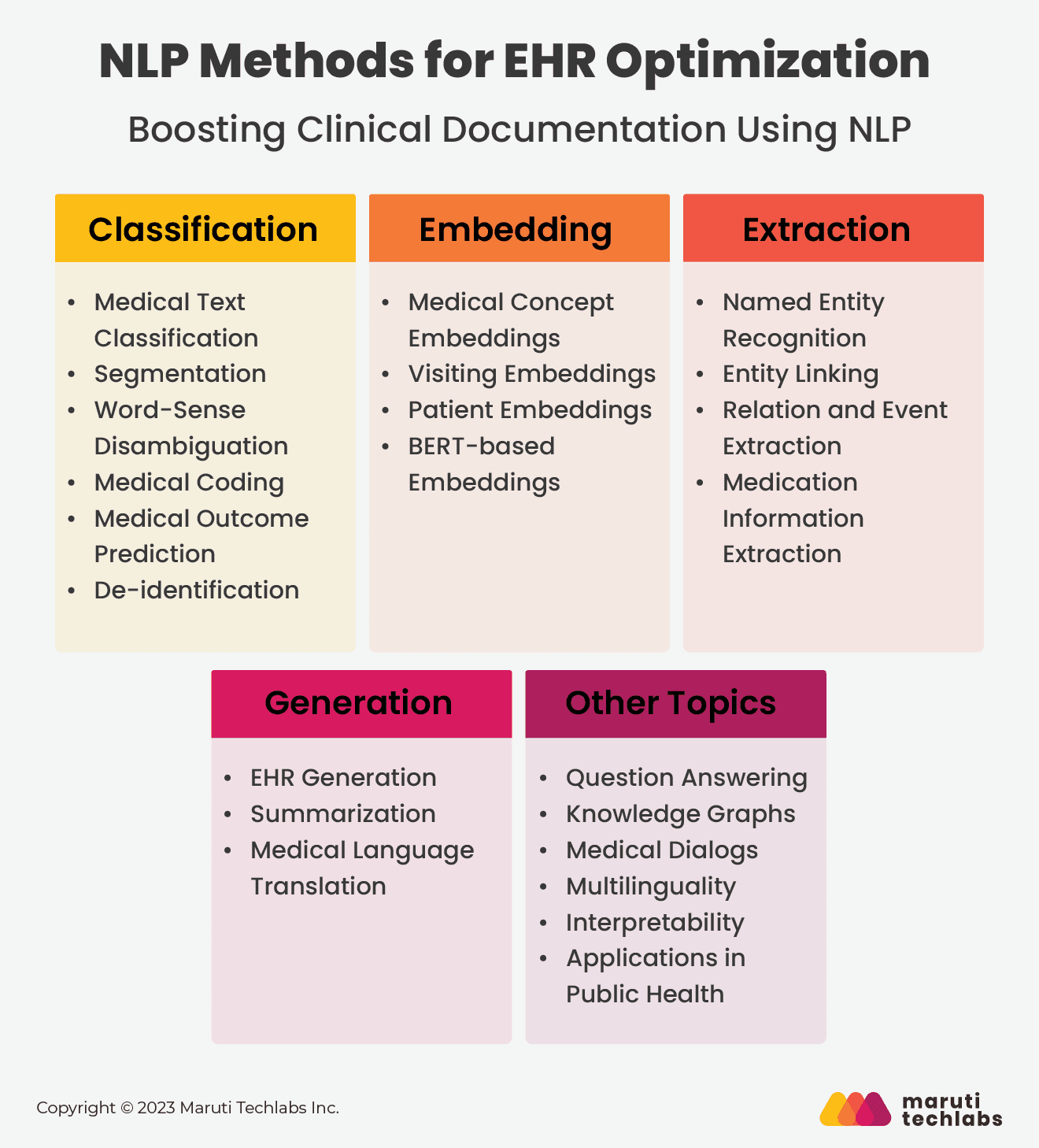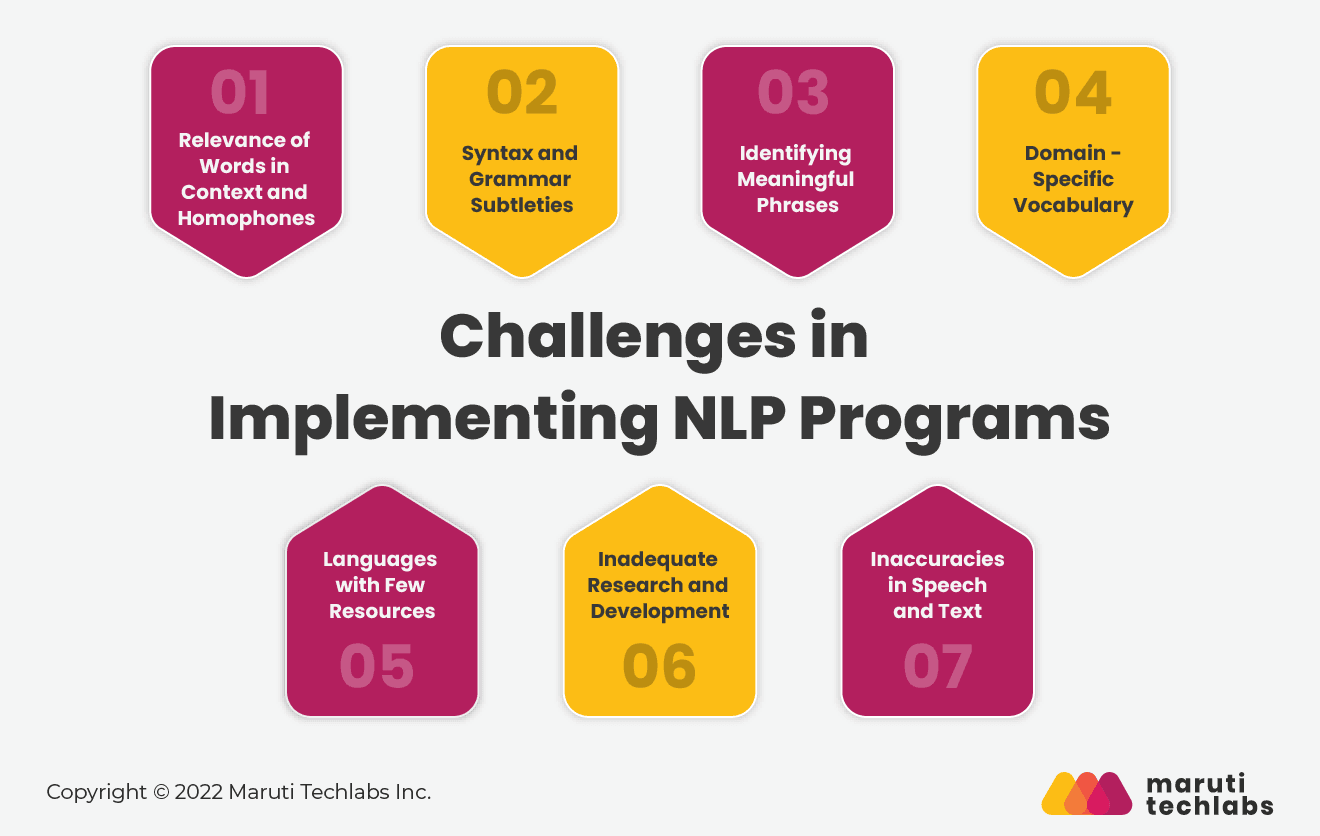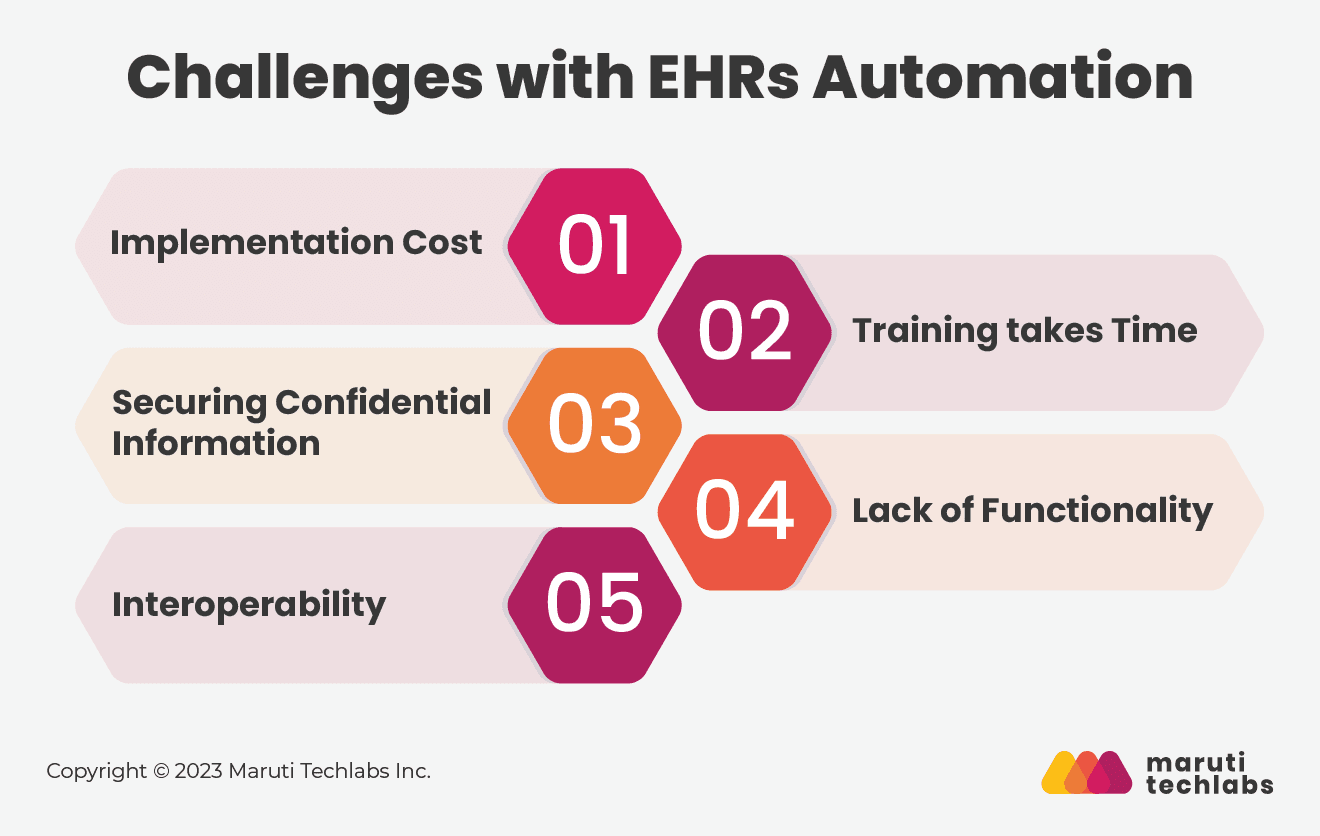

Clinical NLP - How to Apply NLP for EHR Optimization






Care coordination for health providers has been largely eased with the help of EHRs (Electronic Health Records). But with 70% of clinically relevant data being stored in practitioner notes in the EHRs, care coordination needs more than just EHRs.
Due to the lack of structure and uniformity in such practitioner notes, drawing insights from the data stored in EHRs is still a major challenge. It can be largely solved by EHR intelligence and EHR optimization. And this is where NLP in healthcare comes in.
NLP (Natural Language Processing) provides a computational approach to synthesizing such content. Simply put, clinical NLP helps unlock the valuable insights contained within EHR data, leading to improved patient outcomes and overall healthcare quality.
An Electronic Health Record (EHR) is a digital version of a patient's health information. It contains comprehensive and up-to-date records of a patient's medical history, diagnoses, medications, allergies, test results, and other important health-related information.
EHRs are designed to provide a more comprehensive view of a patient's health status by integrating data from various sources, such as hospital records, physician notes, lab test results, and imaging studies.
NLP for EHR (Electronic Health Record) or clinical NLP is beneficial as a significant amount of vital medical data is stored in unstructured free text fields within EHRs.
Since these are unstructured free text, there is little to no standardization of content, format, or quality. Hence, converting these unstructured free text fields into valuable, quantifiable data is challenging.
Clinical NLP can be used to analyze free text fields in electronic health records by training algorithms to identify important information based on patterns and rules learned from a large volume of EHR notes.
Additionally, NLP techniques can capture unstructured data, analyze the grammatical structure, and determine the meaning of the information.
To summarize, clinical natural language processing is a promising approach to rapidly analyzing massive amounts of EHR notes, extracting quantitative data, and providing insights.

Most medical writing is free-form, full of jargon and acronyms, and may have typographical or spelling errors. Since there is no universal vocabulary of medical acronyms, their meanings are not always clear or easily understandable.
Algorithms utilizing clinical NLP in EHR automation extract vital information from clinical notes, such as diagnoses, recommendations, timetables, and false symptoms.
Once the relevant information is extracted, it is organized according to various categories like patient demographics, medical history, and current medical issues for easier access and analysis.
This can facilitate systematic research and help healthcare providers make more informed decisions based on the available data.
Clinical NLP can also be used to summarize vast amounts of data extracted from clinical notes.
With the ability to analyze the grammatical structure and categorize the text, NLP algorithms can create concise summaries of clinical notes for a group of patients. This can help researchers and physicians quickly identify medical symptoms and treatments.
A phenotype is the outward manifestation of a genetic characteristic in an organism, which can include physical appearance, behavior, and bodily functions. Doctors use phenotyping to group patients and compare data easily. Structured data is preferred for phenotyping because it is easy to extract and analyze.
However, despite the preference for structured data, around 80% of all patient data remains unstructured, making it difficult to use for phenotyping. Clinical NLP can extract and analyze unstructured patient data. This facilitates the creation of phenotypes for patient groups with a large amount of data.
Chart reviews often necessitate the knowledge and experience of a Registered Nurse (RN) because they include reading through several reports on a patient to get a comprehensive understanding of the patient's medical history.
To help doctors quickly understand a patient's medical history, clinical NLP summarizes and visually represents information for the chart review.
Patients for clinical trials have typically been selected by more time-consuming and error-prone techniques, such as manually checking medical records. If the condition is uncommon, there are even fewer patients available.
NLP technology integrated within EHRs is efficient for e-screening and patient cohort identification, as it recognizes keywords and displays relevant information to experts.
NLP contract management analysis can be used for administrative tasks. Additionally, clinical NLP aids with making follow-up calls after a patient's doctor visit.
By extracting essential information from reports and creating patient profiles, clinical NLP can assist in determining appropriate follow-up recommendations.
Healthcare practitioners can effectively manage patient care by electronically communicating health information across multiple systems.
EHRs facilitate easy retrieval of medical history and make the invoicing and coding processes more streamlined.

Automatic medical text classification is one of the NLP technologies that extract information integrated into medical records. Machine Learning methods in healthcare are beneficial for medical text classification jobs.
Text segmentation is the method of dividing a text document into coherent and meaningful adjacent sections. This task is vital for NLP apps like question-answering, context understanding, and summarization.
Word-Sense Disambiguation (WSD) is an approach to identifying the intended meaning of a word in a given context or sentence. It brings clarity of communication and makes EHR automation more effective.
It is uprooting billable information from a medical record and translating it into standardized codes utilized for medical billing. Using electronic health records can resolve human errors and improve the reliability of results.
Medical output prediction from the medical text can avert doctors from overlooking viable threats and enable the hospital to organize capacities. The practical approach should surmise results based on a patient's risk factors, symptoms, and pre-conditions.
It is an intense technology to empower the usage of unformed medical text while securing patients' confidentiality and privacy. The medical NLP community has invested enormous efforts in creating approaches and entities for de-identifying medical notes.
Medical notions in EMR data are embedded with the time stamps. The worldly information in EMR data can ease clinical concepts associating by enhancing the concealed rendition of contexts.
Electronic health records in healthcare hold information on patients' healthcare over several visits, such as drug prescriptions, disease findings, solutions, etc. The enormous potential of such data in the healthcare arena is vast.
These are other methods to take benefit of EHR comprehension and secondary use and help in better result prediction and decision-making.
BERT controls the strength of transformers to create decent word embeddings than previously. Embeddings derive ailing to text from particular domains like biomedicine.
NER, also termed entity identification, entity extraction, and entity chunking, is a part of information extraction which involves identifying and extracting specific entities (such as medical codes, names of people, places, organizations, etc.) in unstructured text data.
Entity linking, also termed named entity disambiguation and recognition and named entity normalization, is the task of giving an unmatched identity to entities described in the text.
This task identifies embedded entities via a connected fitting particular relation sort. It is typical in healthcare as an NLP should adapt the relationships between different clinical entities to understand the patients' records thoroughly.
Medical information extraction is one of the vital kinds of medical data in electronic health records. It evaluates healthcare quality, safety, and clinical research utilizing the data in electronic health records.
 4. Generation
4. Generationa. EHR Generation
Natural Language Generation (NLG) is a widely adapted component of an NLP. Regarding EHR automation, NLG is used to make perfect medical text from existing medical documents. EHR intelligence is profoundly vital in the medical domain due to the uneasiness of EHR's confidentiality and accessibility.
Healthcare experts and researchers deal with enormous numbers of electronic health records daily. Text summarization, the essential task in clinical NLP, could minimize their jobs by confining documents into readable summaries.
Medical translation is one of the practices in NLP used for translating various documents, drug data sheets, medical bulletins, training materials, etc.- for marketing, medical devices, healthcare, or technical, regulatory, and clinical documentation.
Question Answering (QA) is the assignment of interpreting normal language questions and answering suitably matched answers. Open-domain QA frameworks have had recent success with pre-prepared language models. Yet, these outcomes have not extended to biomedical QA due to its domain-centered difficulties.
The core of the knowledge graph is a knowledge model: a stack of interconnected descriptions of events, relationships, concepts, and entities. Knowledge graphs put information in the setting by means of connecting semantic metadata and, this way, offer a framework for data analytics, unification, integration, and sharing.
Medical dialogs, i.e., the conversations or exchanges between healthcare providers and their patients, are a reliable source of information for caregivers and patients. Natural Language Understanding (NLU) research on doctor-patient dialogues has potential implications for automatic scribing and automatic health coaching applications.
Multilingualism, as the name suggests, is the utilization of more than one language, either by a group of speakers or an individual speaker. It is accepted that multilingual speakers outnumber monolingual speakers worldwide.
Interpretability refers to the ability to understand and predict the results of a system or algorithm based on its inputs and parameters. It allows users to see how and why a system makes certain decisions or predictions and make adjustments if necessary.
Public healthcare service providers have one more source to revise while seeking information, persuasive material, or data that will enable them to protect and promote public health.
Additional Read - Working & Application of Sentiment Analysis
Despite NLP's ability to process large amounts of text data and derive meaningful insights, developing highly accurate NLP programs that can effectively process free text in a clinically-meaningful way remains a challenge. Some of them include-

Many terms, especially in English, have similar pronunciations but entirely different meanings. The meaning of a given word or phrase can change based on the context of its use.
Homonyms, or pairs of words that share a pronunciation but not meaning, can confuse question-answering and speech-to-text systems. Even humans find it hard to distinguish words like "their" and "there."
Accurately interpreting language syntax and grammar can be a major challenge. For instance, the period after "Dr." does not necessarily indicate the end of a sentence.
It can be difficult for NLP algorithms to identify the start and end of meaningful phrases.
For example, identifying the meaning between similar terms like "irritable" and "extremely irritable."
The jargon used in various sectors of the economy might vary widely from one another. In contrast to the NLP processing model used for legal documents, the one required in the healthcare industry would be somewhat different.
While many specialized analysis tools are available today, businesses operating in very specialist areas may still need to develop and prepare their algorithms.
Most NLP applications using AI machine learning have been developed for the most generally spoken languages. It is pretty remarkable how much progress has been made in the effectiveness of machine translation.
Many languages, however, particularly those expressed by individuals with limited access to technology, often go neglected and inadequately processed. For instance, there are approximately 3,000 languages in Africa alone, but there isn't much information on many.
To reach its full potential, machine learning needs access to vast amounts of data, ideally billions of examples to learn from. As more information is used to train NLP models, the more sophisticated they become.
Training NLP models can be arduous and may require external assistance from experienced natural language processing consultants.
However, new forms of machine learning and bespoke algorithms are being developed daily to deal with the ever-increasing volumes of data.
Words spelled incorrectly or used in the wrong context can hinder text analysis. Common typos can be corrected by autocorrect and grammar checkers, but they don't always catch on to what the writer means to say.
EHR intelligence algorithms have difficulty grasping spoken language because of mispronunciations, accents, stutters, etc.
If you are new to EHR automation, knowing what you are getting into is important. Implementing and automating EHRs is a significant investment - both in terms of time and cost. Here’s a brief list of challenges so you know what to expect.

The expense of EHR integration is a significant deterrent for healthcare businesses. Nonetheless, it appears to be a good investment thus far. Optimal system implementation increases profits while decreasing expenses and improving productivity.
Professionals need in-depth training on the new workflow before implementing electronic health records. Clinicians and the rest of the medical staff must invest more time in learning the new system to implement it effectively.
Patients' and doctors' worries about publicly sharing their personal information is another significant barrier to adopting EHR optimization systems. The potential for data leaking due to a cyber assault is a frequent concern for clinical practitioners.
Clinicians have trouble adjusting to an electronic health record system if it doesn't mesh well with their current procedures. The EHR optimization system cannot be designed with a one-size-fits-all mentality, as the workflow of a therapist differs significantly from that of a cardiologist. Design defects and inadequate training compromise the usability of EHR automation software.
Patients' medical records can be easily shared with their doctors and hospitals through interoperability. Due to the absence of interoperability, it can be challenging to determine what medical problem necessitates treatment.
Natural language processing has numerous possible uses in the medical field. By converting free-form text into structured data, natural language processing may improve the thoroughness and precision of electronic health records, significantly contributing to EHR optimization.
This way, it is possible to populate data warehouses and semantic data lakes with valuable data that can be queried using NLP tools. Providers may be able to dictate their notes into the system, streamlining recordkeeping, and it may also be able to produce individualized discharge education materials for patients, boosting EHR usability greatly.
But perhaps most immediately relevant is that NLP in healthcare can and is being utilized for clinical decision support, which is of tremendous interest to clinicians in dire need of point-of-care answers for highly complicated patient issues.
The gap between the inconceivable volume of data created daily and the human brain's limited processing power may one day be closed using clinical natural language processing techniques.
EHR automation may be transformed from a burden to a blessing by clinical NLP, which applies to anything from the most cutting-edge medical applications to the simplest process of coding a claim for billing and payment.
Accurate, clever, and healthcare-specific algorithms will be essential, as will the design of user interfaces that make clinical decision-support data digestible. It may be difficult to fully realize the potential of NLP in EHR automation if it doesn't achieve these two aims of extraction and display.
UCHealth, a customer of Maruti Techlabs, is one of the primary healthcare service providers in the UK, overseeing a vast network of medical facilities.
Not just general medical centers, but UCHealth also oversees diagnostic centers and pharmacies. They improve the effectiveness and availability of medical treatment.
A large number of discharge, referral, and follow-up letters would be written by physicians at these hospitals and clinics daily. UCHealth's data teams would need to manually review, categorize, and update the data from these diagnostic letters into specified categories to keep patient records up to date.
Since there was such a large quantity of letters, a sizable crew was assembled to examine them and hand files the data into UKHealth's HIMSS database. Manually entering and organizing the data into the appropriate systems took much time and effort. As a result, there was a fair likelihood of mistakes or disparities.
Based on the vast number of letters that would otherwise need to be read and manually sorted, Maruti Techlabs developed a machine-learning model to automatically extract the data from the letters and sort them into one of three predetermined categories.
The ML team came up with a 2-stage procedure for text extraction and identification to accomplish this goal:
The machine learning algorithm first required a massive volume of diagnostic letters to be sorted and converted into a structured dataset.
First, they had to scan all the diagnostic letters and save them as electronic files. They used Optical Character Recognition (OCR) to teach the text extraction model to detect and analyze text from these digital files.
The computer examined the correspondence's structure and extracted components like text, photos, tables, etc. After the characters had been isolated, the model moved on to the next phase: NLP-based identification.
Next, they had to provide the model with a way to understand the extracted text and sort the characters appropriately. They developed an NLP algorithm for this purpose. The model could convert words and phrases into numerical vectors (indicating the meaning of the words) and then match those vectors to the appropriate entities using natural language processing.
The ML model learned to recognize statements like "see you in three months," "totally discharged," "not necessary to meet again," etc., in their respective contexts. To streamline the updating and administration of patient information, the team incorporated the complete machine learning model into the client's centralized HIMS.
Read - Deep Neural Networks Addressing Challenges in Computer Vision
Electronic Health Records (EHR) in healthcare is a state-of-the-art method that perfectly facilitates and streamlines maintaining medical records by digitizing all allied documents.
By reinforcing EHR intelligence with clinical NLP, the EHR system can give additional benefits so that healthcare service providers can make the most relevant decisions based on remarkable clinical data.
Maruti Techlabs offers state-of-art clinical NLP services. Our Natural Language Processing (NLP) services offer sentiment analysis, entity extraction, intent classification, and text categorization.
We have proven expertise in different disciplines of machine learning and artificial intelligence, such as NLP, deep learning, computer vision, and cognitive computing. With the right combination of technologies and skills, we have helped companies worldwide process unstructured data and determine the underlying meaning of the words.
Connect with us to optimize your EHRs and be a better care provider!
1. What is an electronic health record?
It's a computerized database that includes a person's health records, such as a patient's diagnosis, medications, lab results, allergies, vaccines, treatment plans, and other relevant health information in digital form.
2. Why do we need NLP in healthcare for electronic health records?
Natural Language Processing, often known as NLP, offers some exciting and one-of-a-kind possibilities in healthcare. It makes it possible to navigate the large quantity of new data and use it to its full potential to improve outcomes, save costs, and provide a great level of care.
3. What are the challenges in electronic health records?
The deployment and use of recent developments in health information technology, such as Electronic Health Records (EHRs), may be prohibitively costly. Finding the money to spend on training, support, and even the physical infrastructure may be a typical obstacle, particularly for practices that are not as large.
4. What are the benefits of EHR automation?
The advantages of using electronic health records (EHR) automation include better health care. All facets of patient care, such as safety, efficacy, patient-centeredness, communication, education, timeliness, efficiency, and equity, are improved due to the use of these records.
5. What is an EMR in healthcare?
In places like doctors' offices, clinics, and hospitals, Electronic Medical Records (EMRs) have replaced paper charts. EMR optimization is primarily utilized for diagnostic purposes, and as such, they include notes and information gathered by and for the physicians at that office, clinic, or hospital.
6. What are the different EHR intelligence systems?
There are several methods EHR optimization systems are configured. Each way has its pros and cons, depending on the unique needs of medical practice.
a. Physician-HSystemosted
In these systems, all data is hosted on the own servers of physicians. They are responsible for buying their hardware and software and maintaining the server's security and maintenance. These systems are advantageous for larger practices, and on-site servers can speed up the EHR intelligence system.
b. Remotely-Hosted System
A remotely-hosted system means managing data with a third party. This system lets physicians focus on collecting the information, not its storage. Therefore, a remote-hosted system eliminates the IT headache of physicians and helps them keep their patients' care more attentive.
The remote system has three different varieties.

